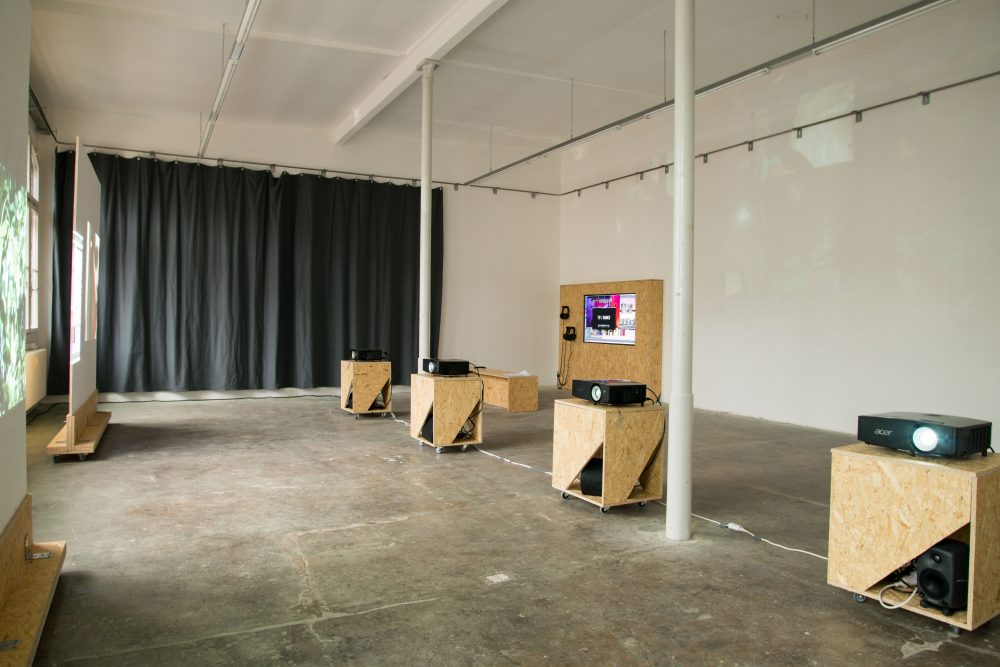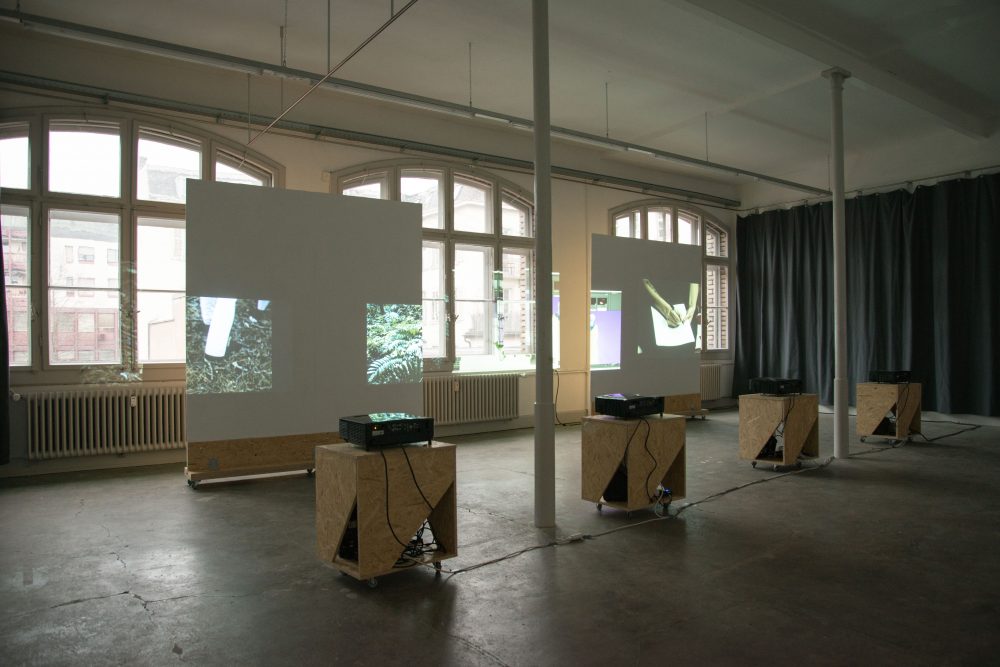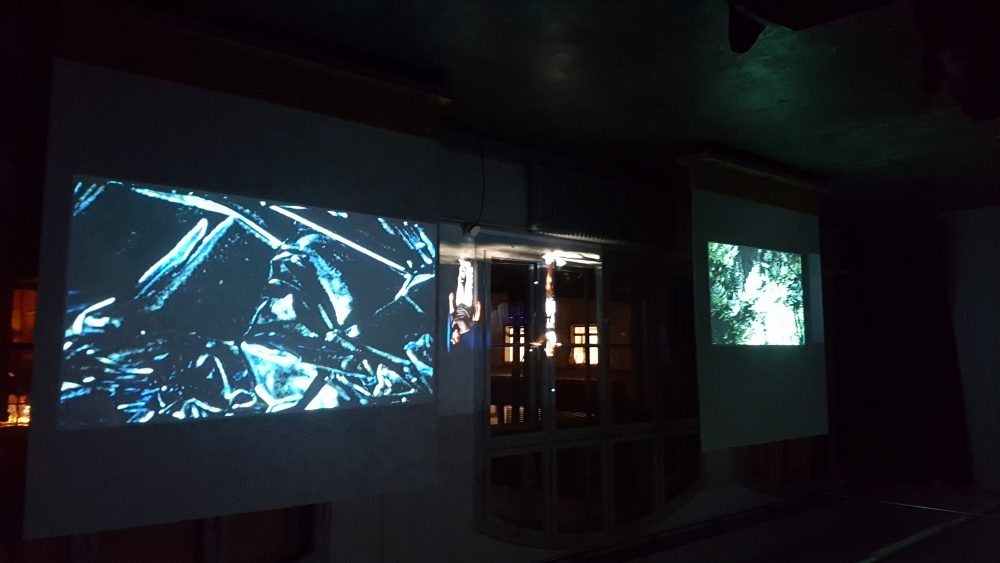Deutsche Version unten
23 March – 11 April 2018
Queering the exhibition
in collaboration with zürich moves!
22 March 2018, 6.30 pm
Contributions by Hana Earles, Maëlle Gross, Anna Linder, Nunzio Madden, OMSK Social Club PUNK IS DADA, Pil & Galia Kollectiv, Marilou Poncin, Tabita Rezaire, Roee Rosen, Scagliola & Meier, Nicolaas Schmidt, Bo Zheng
Curatorial Group: Damian Christinger, Kristina Grigorjeva, Christine Kaiser, Ronald Kolb, Ella Krivanek, Marco Meuli, Camille Regli, Dorothee Richter, Oliver Rico, Elena Setzer
Taking queer practices & theories as a point of departure, ‚Queering the Exhibition‘ suggests both a conceptually and formally polyphonous environment of 12 video artworks by several artists. Against naturalized, binary subject constructions this group show puts ambiguity, fluidity and layering at the forefront to enhance multiple levels of subjectivity. By challenging its format, the exhibition invites the visitor to perpetually reconfigure the offered narratives.
The exhibition was inaugurated by Elie Autin’s and Juliette Uzor’s performance How can I call what is between us (II).
The Oncurating Project Space (oncurating-space.org) organizes this exhibition with young curators of the Postgraduate Programme in Curating, Zurich University of the Arts (curating.org) in collaboration with alumnus Marc Streit for zürich moves! (festival for contemporary arts practice in performing arts).
Opening times: Tue–Thu, 4–7pm or by appointment (info@oncurating.org)
Contributions:
Elie Autin & Juliette Uzor, How can I call what is between us (II) (2018)
The performance is an interaction between Elie, Juliette and the audience. While listening to Ravels’ Bolero, there is time to look carefully, to notice minor changes of the rhythm and to perceive subtle, emotional impulses. Gestures and signs from the present moment are received to influence and lead the performers in their choreography: Elie follows Juliette and Juliette follows Elie. It is a situation of dependency and expectations. The title refers both to the relation between the moving performers and the audience in the actual time and space, and to the personal and biographical relationship between Elie and Juliette.
Born and raised in Toulouse, France, Elie Autin attended the local ‚conservatoire de la danse‘ and is currently pursuing his studies in contemporary dance at the Manufacture in Lausanne. Alongside his dance training, he works as a model and is involved in various film projects. Juliette Uzor grew up in St. Gallen and also studies contemporary dance at the Manufacture in Lausanne. Before attending the course, she studied art & mediation and art history in Zurich and Bern. Among other, her performances were presented at the Kunsthalle Zurich and the Klöntal Triennial.
Hanah Earles, I’m The Arrow (2018)
Hana Earles’ work investigates the corruption of objecthood as well as materiality and how this might inform and represent the capitalised gendered subject.
Based in Melbourne, Hana Earles (*1993) works with painting, sculpture and installation techniques that utilise both of these form. She has been included in a variety of exhibitions including a solo show at Punk Cafe in 2016.
Maëlle Gross, Strike A Pose (2013)
In Strike a pose, Ariane, a female bodybuilder challenges the codes of beauty and the aesthetics of gender by excessively controlling the image of her body, curating it as a sculpture.
From Greek origins, Maëlle Gross (*1988) is interested to explore the different layers of social/cultural conditions across various media, including installation, photography and video documentary. Her work tackles notions of hyper subjectivity, memory and power structures. Based in Lausanne, her work has been shown in various institutions including the Centre d’art contemporain in Geneva (2017), a solo exhibition at Flux Laboratory in Zurich (2017) and was commissioned to create site-specific „art walks“ in the area of Kipseli in Athens (2017) and in the Pâquis in Geneva for Antigel Festival (2018).
Anna Linder, Spermwhore , (2016)
Spermwhore is an experimental super-8 film about unwanted childlessness in a world where normative heterosexual relationships dictate who can become parents and in what way. When it comes to reproduction our merciless bodies reduce us to merely a set sex or given gender. But the longing for children is not limited to our bodies, and the possibility of pregnancy can be gifted, shared and undertaken together.
Anna Linder (*1967) lives and works in Gothenburg and Stockholm, Sweden. Working as an artist, independant curator, producer and researcher, she is active in the field of moving images with a special focus on experimental queer material. Her works have been exhibited and screened in international institutions and festivals (ICA London, IFFR Rotterdam, Arsenal Experimental in Berlin et al.) and since 2018 she is the artistic director of The Swedish Archive for Queer Moving Images.
Nunzio Madden, Final Form Part 1 (2016) & My Body Is Wrong (2017)
Final Form Part 1 is an investigation into non-normative forms of masculinity, which combines disparate images and scenes from video games with hand drawn animations, accompanied by audio of Nunzio’s father singing hymns to his grandmother in hospital. My Body Is Wrong is a two-part film that was formed during the process of being misdiagnosed as intersex and undergoing surgery.
Nunzio Madden is a transexual Slovenian-Australian artist, living and working in Naarm,Melbourne. Nunzio has exhibited works at the Berlin Biennale, Westspace, M.I/mi1glissé, Punk Cafe and Info Punkt in Melbourne.
OMSK SOCIAL CLUB FKA PUNK IS DADA, MEAT SPACE # MY GIRLFRIEND IS THE
REVOLUTION (2014)
The 9-minutes video MEAT SPACE # MY GIRLFRIEND IS THE REVOLUTION represents a new genre of ephemeral action, by commodifing the cultural shift from Cyberpunk 90’s dream utopias to the legitimacy of reality in cyberspace (i.e. identity and anonymity in cyberspace). Considering herself as ‘futuristically political’, OMSK SOCIAL CLUB FKA PUNK IS DADA is proposing content and makings as a form of post-political entertainment. The content examines virtual egos and experiences allowing the works to become a dematerialised hybrid of modern day culture.
Pia & Galia Kollectiv, Better Future, Wolf-Shaped (2008)
In Better Future, Wolf-Shaped, a peripheral cult of worshipers fashions its own offerings to their Modernist ancestors. Bringing together pagan rituals, the anti-traditions of modernism, popular film and music interpretations as a social unit, the video work aims to trace connections between historical moments as much as write its own chronology of an alternative future history. The appropriation of consumer culture and the relationship between the mass produced and the hand-made becomes a field for questioning the potential of art as political action.
Pil and Galia Kollectiv are London-based artists, writers and curators working in
collaboration. Their work is multidisciplinary – encompassing film, animation, collage, poster production, sculpture, installation, performance and costume design – and explores the relationship between art and politics, the legacy of modernism, and the avant-garde discourses of the twentieth century.
Marilou Poncin, Cosmic Ass (2015)
Cosmic Ass is a multi-dimensional video work in which Fannie Sossa, an activist in feminist theories, narrates the origins of twerking, playfully stating that the dance is at the intersection of diaspora, Afro-American identity and sexuality. It can be perceived as an embodied feminism, a protest and an approach to spirituality: “I twerk to remember, I
twerk to resist.”
Marilou Poncin (*1992) is a French artist based in Paris, whose work interlaces sexuality and fantasies in the virtual worlds. Despite having shown in several festivals and exhibitions, Poncin was awarded by the Inrocks Lab’s contest for the young creative video direction scene (2015), and was nominated and selected for the European Photography Prize (2016).
Tabita Rezaire, Same Sex Biz (2014)
Same Sex Biz is a fragmented display of struggles of emancipation from gender based and sexual oppressions. Recorded in Maputo, Mozambique, the video is a prayer for love, which creates a chaotic sample of the complex situation that are faced by African homosexuals today.
From French origins (and Guyanese and Danish descents), Tabita Rezaire (*1989) is a video artist, a health-tech-politics practitioner and a yoga teacher based in Johannesburg. Her practices unearth the possibilities of decolonial healing through the politics of technology. Navigating architectures of power – online and offline – her work tackles the pervasive matrix of coloniality and its effects on identity, technology, sexuality, health and
spirituality.
Roee Rosen, Out (“Tse”) (2010)
The 34-minutes film presents a domination/ submission scene set in a mundane living room. The increasing pain prompts the sub to spew out not only cries of pleasure and pain, but also sentences. The scene connotes both confessions under torture, and rituals of exorcism, even as it remains a documentation of willful pleasure.
Based in Jerusalem, Rosen (*1963) has exhibited all over the world with different media, including paintings, video art, installations, multimedia, artist books and writing. He exhibited at the Tel Aviv Museum of Art (2016) and at the Edith Russ Haus in Oldenburg, Germany (2016) among others and was recently presented at Documenta 14 (2017) in Athens and Kassel.
Rico Scagliola & Michael Meier, Disintegrating Male ( 2016)
The precise observation of the people surrounding them is the starting and focal point of the artistic collaboration between Rico Scagliola and Michael Meier. Based in Switzerland, the artist duo collects audiovisual attributes and narratives that construct the identities of individuals or groups and explore how they relate to the self-perception of a social collective.
Scagliola (*1985) & Meier (*1982) have exhibited their work in solo and group shows, such as Kunsthalle St. Gallen, Atelier Hermann Haller, Zurich, Kunsthalle Zurich, Fotomuseum Winterthur and Drei/Raum für Gegenwartskunst, Cologne. They published two books with Patrick Frey Editions: Neue Menschen (2011) and Years Later (2017).
Nicolaas Schmidt, AUTUMN (2015)
The work AUTUMN is a no dialogue stereo work complemented by:
The noise of the last leaves up into the crowns of trees. / Two heards running against the wind. The sound of falling water in a bathroom. / Touch me I wanna feel your body. A window to autumn and leaves on the ground, a desperate question. / The power of everlasting big big love. / A film about approaching ends – last years, weeks, seconds. / A Romantic Conceptualism Love Porn Tragedy.
The Hamburg based artist Nicolaas Schmidt (*1979) works with various media and
concepts with a particular focus on atmospheric dramaturgies, characterized by
repetitive elements of emotion, reduction, banality and radicalism. His works were internationally shown at film festivals and exhibitions , and he was awarded by the German Film Critics Association (2018) as well asby the Special Jury Prize at the Berlin International Film Festival (2017)
Bo Zheng, Pteridophilia (2016)
The 17-minutes film explores the eco-queer potential of six young men walking into a forest in Taiwan and have sex with ferns plants.
Based in Hong Kon, Bo Zheng (*1974) is an artist, writer, and teacher, committed to socially and ecologically engaged art. He investigates the past and imagines the future from the perspectives of marginalized communities and marginalized plants. Zheng worked with numerous museums and art spaces in Asia and Europe, most recently with Hong Kong Museum of Art, Times Museum in Guangzhou or Power Station of Art in Shanghai among others.





